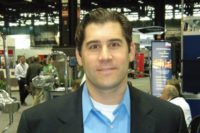Since its construction six years ago, Beef Products Inc.'s South Sioux City plant has undergone one improvement and expansion after another.
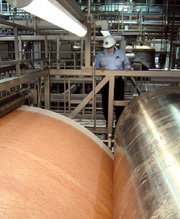
Restless energy is the defining feature of Beef Products Inc. (BPI), the Dakota Dunes, S.D.- based meat processor that has spent the last quarter-century reinventing the way lean meat is separated from beef and pork trimmings.
The company is a reflection of its founder and president, Eldon Roth. A refrigeration designer with a genius for invention, Roth has built BPI into the dominant player in its niche: lean meat added to ground beef, particularly when making hamburger patties for quick service restaurants (QSRs). Since its startup in 1981, BPI has built plants in Amarillo, Texas, Finney County, Kan., Waterloo, Iowa, and South Sioux City, Neb., where BPI's crown jewel stands. Constructed in 1998 and physically connected to an adjacent Tyson Fresh Meats (formerly IBP) packinghouse where 6,000 head of cattle are processed each day, the South Sioux City plant underwent $27 million in expansion and plant improvement in 2003.
The largest investment was in a project atypical of BPI: a cold storage facility separated by a rail line from the plant and connected by an enclosed archway. The freezer features an automated storage and retrieval system (AS/RS) by Westfalia Technologies Inc. It is a rarity because the equipment and technology were not developed in house.
More reflective of the company's approach is a new pH enhancement process that significantly reduces microbial loads in finished goods. Ammonia gas is injected into lean meat under pressure to form ammonium hydroxide and raise the pH to 9, effectively eliminating most meat pathogens of concern except Listeria. The process was conceived, designed and built by BPI engineers. Ammonium hydroxide is used as a processing aid in many foods and beverages; applying it to beef without affecting the taste "was a huge challenge that took six years to overcome," according to Roth.
Other recent projects include replacement of eight lean-from-fat centrifuges with new units-designed and specified by BPI's six-person mechanical design staff-and alterations to the facility's Roller Press Freezers that convert meat from a viscous, 105
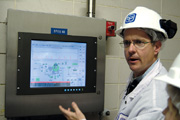
Right time, right ideas
Roth left his native South Dakota as a teen and lived and worked in California until he was 45. Refrigeration technology was his passion, and his company, Freezing Machines Inc., engineered and built equipment for clients who were more quality- than cost-conscious.
When the beef industry began to consolidate operations in massive packinghouses in the Midwest, Roth saw an opportunity to return to his roots and process never-before-available quantities of fresh trimmings. On the strength of a handshake agreement with the head of IBP, Roth built the first BPI facility.
A decade of work by Roth in dairy plants is reflected in the South Sioux City facility: acid pavers provide the flooring, glazed tiles with epoxy grout form the wall surfaces, and stainless steel curbs tie together the perpendicular plains. Iron is almost absent from the processing floor: bearings and other components have been designed and engineered to use other materials wherever possible. Unsatisfied with commercially available fittings, BPI engineers specified their own sanitary piping ferrules and gaskets.
The dairy model also is apparent in the way product moves through the plant. From the time it leaves the grinders until it reaches the contact freezers, meat is enclosed and conveyed in stainless steel pipe. Separation of fat from lean is accomplished in a uniform fashion in a shell-and-tube heat exchanger with minimal mechanical working to maintain product quality. To move product at a consistent rate, enormous positive displacement pumps of sanitary design are used. In some cases, rotors weighing more than 400 lbs. are required. Niro, Waukesha Cherry Burrell and other machine shops have manufactured components to BPI specifications, with final assembly in South Sioux City.
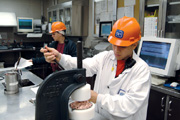
"We designed the ratios, speeds and pressures of those pumps to our specifications," explains Roth. "It may be an engineering nightmare up front, but we're an engineering firm that ended up in processing. More and more of our machinery is designed in house."
Because it is a privately held corporation, BPI is able to operate the way all engineers would love to: with heavy duty, quality equipment that overcomes high up-front costs with long-term paybacks. Machines tend to be replaced not because they fail, but because the staff obsoletes them with a new, superior design. That was the case in last year's overhaul of the separation technology and contact freezing system.
Freezing capacity is the plant's choke point, and the addition of compression belts to the plant's two rotating drum freezers boosted each unit's capacity to 25,000 lbs. per hour. The drums are 14 ft. wide and 12 ft. in diameter, with ammonia refrigerant inside chilling their surfaces to -60

Automated cold zone
The AS/RS freezer, formally known as Dakota Cold Storage, came on line in May. The $19 million project was undertaken at the request of QSR clients who want to source all their lean ingredients from South Sioux City. By managing inventory at its own freezer, BPI is able to provide a higher level of quality assurance and inventory management than if third-party cold storage facilities were used. QSR customers wanted BPI to be able to maintain a sufficient inventory from that plant at a single storage location, according to Ron Yockey, head of corporate operations, and Dakota Cold Storage delivers that capability. With weekly production targeted at 3.5 million lbs. this year, the freezer will be at 84 percent capacity by year-end. Expansion to the north and south was a design consideration.
From the time product is boxed in the plant until it is forklifted onto outbound trucks, human contact is unnecessary and unwanted. Conveyors carry cartons through a 500 ft. long enclosed bridge from the plant to the freezer, where bar-code readers take over the inventorying function. Cartons are palletized, stretch wrapped and stored 10 deep in high-density bays by two cranes. Capacity is 11,800 pallets, or 25 million lbs. of finished goods.
"The SRM (storage/retrieval machine) is a heavy-duty unit and Westfalia's standard unit that you'll find at other installations," says Daniel Labell, president of the York, Pa., firm. "What distinguishes the BPI installation is the sortation software that enables the SRM to re-sort pallets after initial storage." Fat content, moisture and other quality parameters are known when cases arrive, but microbial testing results aren't returned until later. The software program enables the cranes to re-sort pallets at night and stage them to meet customers' particular specifications. Labell compares the system to an installation at Tillamook Creamery, where warehoused cheddar cheese is graded as mild, sharp and extra sharp after 30 days of aging. The grade then is appended to other product information, and inventory is re-sorted.
Slave pallets manage the inventory while it is in the AS/RS and for sanitary reasons never leave the facility. The software creates a paperless system, freeing a skeleton staff to verify shipping invoices from headquarters and eliminating the potential for key-entry errors at the site. Freezer Manager Dave Layhee estimates twice as many workers would be required at a comparably sized conventional cold storage.
Integrating the warehouse management system with BPI's sales office was routine, given the corporation's track record in automation control. The company's pork and beef processing facility in Waterloo, Iowa, marked a watershed in the firm's automation evolution in the early 1990s. For the first time, PLCs replaced hardwired controls and relays. "Although we weren't initially convinced it was the thing to do, the added flexibility was the selling point," recalls Yockey, "because we do so much modification to our processes."
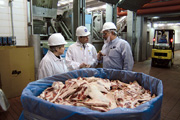
Roth used to configure the electronic controls and would troubleshoot problems in the various plants from headquarters, using the wiring diagrams he drafted. "He had to give up that control, and that was hard," Yockey allows. Rather than delegate the responsibility of modifying processes to the plants, however, BPI instituted a central control command at headquarters. Two technicians man the center around the clock, monitoring thousands of system set points for performance, alarm logging and executing all set-point adjustments in the plants. WAN radio communication is maintained with personnel in the plants; as many as 30 video monitors offer the potential for central command personnel to see in real time what is happening on the processing floor. A CMMS database is being integrated into the central command system, and management hopes to eventually have detailed parts lists and assembly instructions married to the rest of the machine information.
"It's not for everybody, but we believe in a very strong, centralized control," says Yockey. "Our operating people know how their facilities are working, and they regularly call us with feedback like, ‘A gearbox in a high-pressure pump application is not meeting the set point for oil temperature; the proportional integrated derivative needs to be altered.' By making the change here and logging it in, we eliminate the potential of undocumented local changes that result in big problems later."
"We have a saying: Communicate and cooperate," adds Roth. "Plant people still are involved in the process, but let a computer and command group be accountable for recording change."

The same could be said of most BPI initiatives. Perhaps the most imposing equipment at the Nebraska plant is the air purification system that sanitizes and chills returned air in a waterfall that also disinfects with peroxyacetic acid. Two chambers of approximately 8,600 cubic feet each deliver 300,000 cubic feet of positive air pressure per minute to the processing area. Air is germ free because there are no cooling coils. "Air coils are the biggest bacteria spreaders in a plant," Roth believes. "Conveyor belts are the next biggest, which is why we developed a revolving belt scraper with a mister that sprays peroxyacetic acid at the turns." Helping BPI fill its chemical sanitizing needs is Zep Manufacturing.
Few beef processors can match the firm's commitment to scrupulous food safety screening. BPI began testing its products for the presence of central nervous system tissue from source cattle 2 1/2 years ago, Roth says, putting the company's products in an extremely advantageous position in the wake of America's first mad cow exposure. BPI's test and hold program, with two-hour composite samples tested for pathogens at independent laboratories, leaves management confident that they can head off public health issues.
"In the long run, the new freezer will make us money because it improves food safety," says Roth. The same cost-benefit analysis is applied throughout his plants, from the testing programs to the equipment investments. For those who wonder what a food company would look like if engineers ran it, look no further than BPI.
For more information:
Dan Labell, Westfalia Technologies Inc.,
717-764-1115
Mike Cunningham, Zep Manufacturing,
404-603-7574, mike.cunningham@zepmfg.com
